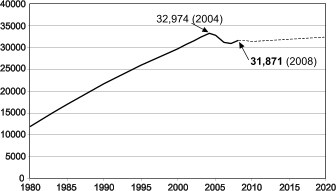9. How can the capacity to decide be improved as the nature of work and institutions change?
Many of theworld’s decisionmaking processes are inefficient, slow, and ill informed,especially when considering the new demands of increasing complexity,globalization, and the acceleration of change. More-open systems,democratization, and interactive media are involving more people indecisionmaking, which further increases complexity—making continuousmodifications of decisions more likely than achieving closure. Fortunately, theworld is moving toward ubiquitous computing with collective intelligence forjust-in-time knowledge to inform decisions; unfortunately, decisionmakingculture can be slow to change.
Decisionsupport software that lets people see how issues have alternative positions andhow each is supported or refuted by research has existed for years but israrely used. Such issues-based information software can make decisionmakingmore clear and transparent (see Figure 23 in Chapter 5). Rapid collection andassessment of many judgments via on-line software can support timelierdecision-making (see Chapter 3). Judgmental information was most often the viewof single individuals or very small groups, but now decisionmaking benefitsfrom the increasing use of open systems that invite broad and transparentparticipation of groups of experts and individuals from around the world.
Vastpeer-reviewed data banks are being interconnected so that composites of datafrom many sources can present the best facts available for a given decision.Issue-tracking for decisionmaking is improving with Web 2.0 tools. Moreuser-friendly, powerful, and flexible simulation and modeling software willeventually find its way into decisionmaking, as have spreadsheet software andsearch engines. Advances in cognitive neuroscience and brain-computer interfacetechnologies should improve decision-support systems.
If Moore’sLaw continues, within 25 years individual computers will have the processingpower of the human brain; hence, much decisionmaking can be automated, just asthe autonomous nervous system manages basic bodily decisions. Meanwhile, toomuch time is wasted going through useless information. The number and intricacyof choices seem to be growing beyond our abilities to analyze and makedecisions. Ubiquitous computing will increase the number of decisions per day,constantly changing schedules and priorities. Decisionmaking will beincreasingly augmented by the integration of sensors imbedded in products, inbuildings, and in living bodies with a more intelligent Web and institutionaland personal collective intelligence software that helps us receive and respondto feedback for improving decisions.
Self-organizationof volunteers around the world via Web sites is increasing transparency andcreating new forms of decisionmaking. Today’s challenges cannot be addressed bygovernments, corporations, NGOs, universities, and intergovernmental bodiesacting alone; hence, transinstitutional decisionmaking has to be developed andcommon platforms created for transinstitutional strategic decisionmaking andimplementation.
Trainingprograms for decisionmakers should bring together research on why irrationaldecisions are made, lessons of history, futures research methods, forecasting,cognitive science, prediction markets, data reliability, utilization ofstatistics, conventional decision support methods (e.g., PERT, cost/benefit,etc.), collective intelligence systems, ethical considerations, goal seeking,risk, the role of leadership, transparency, accountability, and participatorydecisionmaking with new decision support software, e-government, ways toidentify and better an organization’s improvement system, prioritizationprocesses, and collaborative decisionmaking with different institutions.
Challenge 9will be addressed seriously when the State of the Future Index or similarsystems are used regularly in decisionmaking, when national corporate law ismodified to recognize transinstitutional organizations, and when at least 50countries require elected officials to be trained in decisionmaking.
RegionalConsiderations
Africa:Microsoft is collaborating to help e-government systems to improve transparencyand decisionmaking and to reduce corruption. Cape Verde’s e-government includese-voting, which tallies votes within minutes of poll closings, which avoidsconflicts about results. A recent mining boom in Africa will not benefit thelocal population unless the investment is accompanied with good governance. Howcan the cultural advantages of extended families be kept while making politicaland economic decisions more objective and less corrupt? The New Partnership forAfrica’s Development has begun improving collaborative decisionmaking. Africancivil society needs development to pressure for freedom of the press,accountability, and transparency of government. If the brain drain cannot bereversed, expatriates should be connected to the development processes backhome through Internet systems. Informal decentralized networks of alliedpolitical groups within and across boarders are becoming tremendously empoweredby mobile communication devices and online social networking sites.
Asia andOceania: Synergies of Asian spirituality and collectivist culture with morelinear, continuous, and individualistic western decisionmaking systems couldproduce new decisionmaking philosophies. South Korea is exploring collectiveintelligence capabilities.
Europe: Asof May 2008, there were 2,379 multilateral treaties and agreements affectingdecisionmaking around the world; Europe is a major contributor to these, whichis leading to “reporting fatigue.” Bureaucratic complexity, lack oftransparency, and proliferation of decision heads threatens cleardecisionmaking in the EU. Tensions between the EU and its member governmentsand among ethnic groups are making decisionmaking difficult. A globalobservatory and advanced information technology may facilitate publicparticipation in direct democracy.
LatinAmerica: Data for decisionmaking are weak in the region due to lack ofcapacity. In addition to improved efficiency and transparency, themodernization of state decisionmaking requires the design of new agencies andfunctions to attend to new aims of the political policies, with increasingcivil control. Latin America has to improve political educational awareness andthe involvement of the people and to reduce corruption.
NorthAmerica: The region’s dependence on computer-augmented decisionmaking—frome-government to tele-business—creates new vulnerabilities to manipulation byorganized crime, corruption, and cyber-terrorism, as discussed in Challenges 6and 12. Self-organizing groups on the Internet are becoming de factodecisionmakers in the region, with decisions made at the lowest levelappropriate to the problem.
Figure 7.Number of international organizations (NGOs and IGOs)

Source: Union of International Associations Year Book with Millennium Project estimates